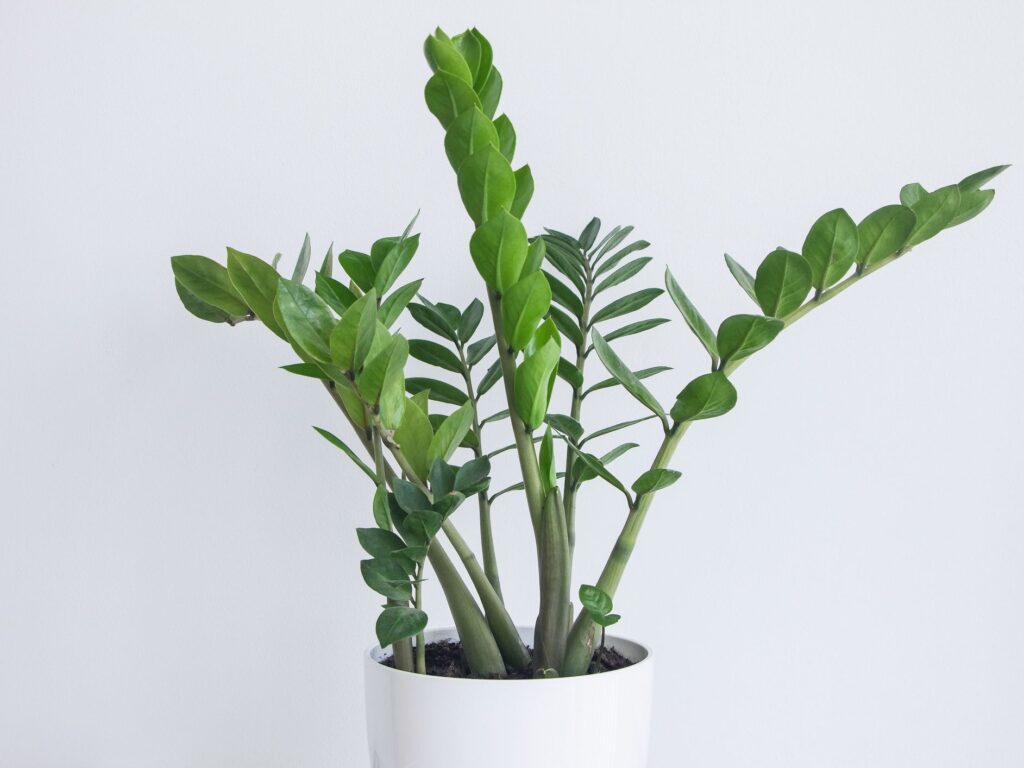Learn how to care for the ZZ Plant!
About ZZ Plant

The ZZ plant is a perennial tropical plant native to eastern Africa. Its moniker derives from its botanical name, Zamioculcas zamiifolia, and you may also know it as Zansibar gem or aroid palm. The ZZ plant is a common ornamental houseplant with waxy, oval-shaped dark green leaves. ZZ plants are extremely drought-tolerant due to their rhizomes, which are underground plant stems that not only grow roots and shoots but also store water and beneficial nutrients.
ZZ plant stems grow in a graceful, wand-like shape that starts thick and bulbous at the base and then tapers to a point. Along the stem are fleshy, oval-shaped leaves that make the plant look like stylized feathers. The entire plant has a waxy, shiny coating that makes it appear to resemble those made of plastic. Between the sculptural qualities of the plant and its waxy coating, it is not uncommon for people to insist that it must be an artificial plant.
How to Care for a ZZ Plant
ZZ plants are low-maintenance and shouldn’t require much of a time commitment. As long as you follow these simple ZZ plant care tips, keeping your houseplant thriving should be a breeze.
Sunlight
Thrives in medium to bright indirect light. Can tolerate lower indirect light. Not suited for intense, direct sun.
Water
Humidity
Don’t sweat it. Average home humidity is fine; can tolerate dry air.
Temperature
Most houseplants prefer temps in the 65°F-85°F range (18°C-30°C). It’s best not to let it go below 60°F (15°C).
Soil
Use a well-draining potting mix. Mix in ingredients such as perlite or lava rocks to increase soil aeration as need.
Fertilizer
ZZ plants generally do not require regular fertilizing to thrive. However, if you’re hoping to increase your plant’s size or vigor, fertilize your plant with indoor plant fertilizer diluted to half-strength one to two times during its active growing season.
Propagating ZZ Plant
ZZ plants are known for their ease of propagation. You can simply divide the rhizomes to make more, or you could take stem cuttings and put them in separate containers once they’re rooted—the choice is yours!
Propagating with stem cuttings is more time-consuming than propagating by division and you may need to wait six months before any new rhizomes begin growing.
Potting and Repotting ZZ Plants
Repotting ZZ plants is a simple process that should only be done when they have grown too large for their pot. This will usually happen because the roots are pushing up against or warping the shape of its container, showing it has outgrown itself in this space.
If you want your Zanzibar gem to live long and prosper, be sure not to repot it during winter. Instead wait until the warmer months of spring or summer when plant activity is at its peak!
Make sure that any potting container has drainage holes for optimal moisture management too–this will ensure healthy growth with minimal stress on its delicate roots.
Common Pests
ZZ plants are virtually disease-free, but keep an eye out for common houseplant pests such as mealybugs, scale, fungus gnats, and aphids that may infest this plant. Use an insecticidal soap to eliminate most of these pest problems.
Leave a reply













